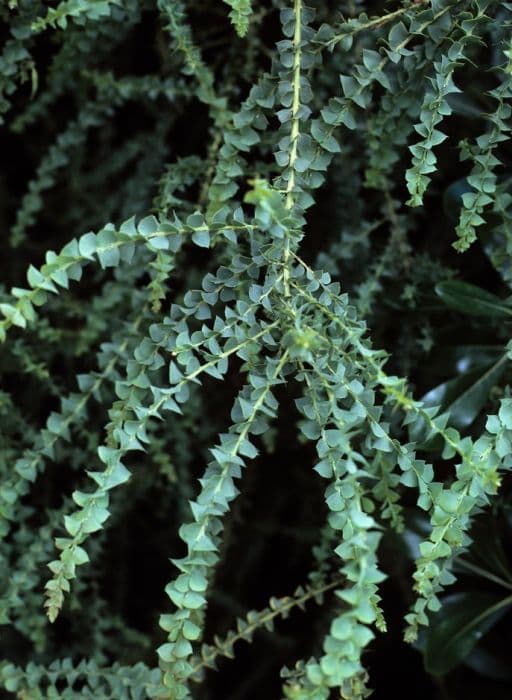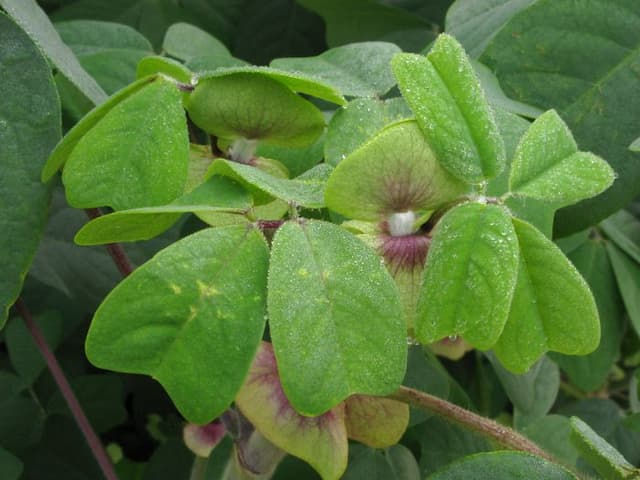Purple Fernleaf Acacia Acacia baileyana 'Purpurea'

ABOUT
The Acacia baileyana 'Purpurea', commonly known as the Purple Fernleaf Acacia, is a distinct and attractive plant. Its most striking feature is the foliage which appears in various shades of purple, particularly during the cooler months or when the leaves are young. Over time, the leaves mature to a blue-gray hue intertwined with the initial purple tones. The leaves of this plant are bipinnate, which means they are arranged on either side of the stem in pairs, with each leaf divided yet again into smaller leaflets, creating a feathery, fern-like appearance that is quite delicate and lacy in texture. This intricate leaf structure gives the plant a soft, fine-textured look that can add a touch of elegance to any landscape. During the blooming season, which most commonly occurs in late winter to early spring, the Purple Fernleaf Acacia produces small, rounded flower clusters known as inflorescences. The flowers are bright yellow, providing a stunning contrast against the purple and blue-gray foliage. The vibrant blooms are densely packed into fluffy, spherical pom-poms that emit a sweet fragrance, which can attract bees and other pollinating insects. While young, its branches have a unique purplish tone, complementing the foliage and flowers. As the Purple Fernleaf Acacia matures, its bark becomes more muted in color but remains smooth and somewhat silvery, contributing to the plant's overall visual interest. Overall, the Purple Fernleaf Acacia is celebrated for its showy leaves and vivid golden flowers, which can add a splash of color and a touch of gracefulness to various garden settings where its size fits the intended design.
About this plant
 Names
NamesSynonyms
Purple Fernleaf Acacia, Purple-leaf Acacia, Cootamundra Wattle, Bailey Acacia.
Common names
Acacia baileyana 'Purpurea'.
 Characteristics
CharacteristicsLife cycle
Perennials
Foliage type
Evergreen
Color of leaves
Blue-green
Flower color
Yellow
Height
20-30 feet (6-9 meters)
Spread
15-20 feet (4.5-6 meters)
Plant type
Tree
Hardiness zones
8
Native area
Australia
Benefits
 General Benefits
General Benefits- Ornamental value: Acacia baileyana 'Purpurea' is highly appreciated for its purple-tinged foliage and fine feathery texture, making it a standout specimen in any landscape.
- Drought tolerance: Once established, it is resistant to drought, making it suitable for xeriscaping and low-water gardens.
- Fast growth: This plant tends to grow rapidly, providing quick coverage or achieving a mature landscape design in a short amount of time.
- Soil stability: Its root system can help prevent soil erosion, particularly in sloped areas.
- Wildlife attraction: It provides a food source and habitat for birds, bees, and other pollinators, which adds to the biodiversity of the garden ecosystem.
- Low maintenance: It generally requires minimal pruning and care once established, saving time and resources for gardeners and landscapers.
- Shade provision: Due to its size and canopy, it can offer a good amount of shade in garden settings, making it useful in hot climates.
- Economic benefits: As a popular ornamental plant, it can have economic value in plant nurseries and the landscaping industry.
 Medical Properties
Medical PropertiesThis plant is not used for medical purposes.
 Air-purifying Qualities
Air-purifying QualitiesThis plant is not specifically known for air purifying qualities.
 Other Uses
Other Uses- Photographic Plate Coating: The tannins extracted from the Cootamundra wattle can be used in photographic solutions for coating plates, due to their ability to react with light-sensitive compounds.
- Landscape Artistry: With its striking purple foliage, the Cootamundra wattle is used for adding a splash of color and visual interest in landscape design, particularly in xeriscaping, for areas with low water availability.
- Potpourri: Dried leaves and flowers of the Cootamundra wattle can be used in making potpourri due to their aesthetic appeal and mild fragrance.
- Natural Dyes: The flowers and seed pods can be used to produce natural dyes for fabric, offering shades of green and yellow depending on the mordant used.
- Erosion Control: Cootamundra wattle is used for stabilizing soils and controlling erosion, particularly in arid regions due to its extensive root system.
- Windbreaks: The dense foliage and fast-growing nature of the Cootamundra wattle make it suitable for creating windbreaks, reducing wind erosion on agricultural lands.
- Education and Research: The distinct morphological characteristics of Cootamundra wattle are useful in educational settings for teaching about plant biology and taxonomy.
- Woodworking: The hard and durable wood of the Cootamundra wattle can be used for small-scale carpentry projects, including decorative objects and woodturning.
- Craft Materials: Seed pods and branches can be utilized in crafting, for example in making natural jewelry or as inclusions in papermaking.
- Scented Sachets: Flowers or crushed leaves of the Cootamundra wattle can be enclosed in fabric sachets to create a subtly fragrant addition to drawers and wardrobes.
Interesting Facts
 Feng Shui
Feng ShuiThe Cootamundra wattle is not used in Feng Shui practice.
 Zodiac Sign Compitability
Zodiac Sign CompitabilityThe Cootamundra wattle is not used in astrology practice.
 Plant Symbolism
Plant Symbolism- Purity: The Acacia baileyana 'Purpurea', commonly known as the Cootamundra wattle, often symbolizes purity due to its bright and clear flowers.
- Eternal and Unchanging Love: In Victorian floriography, acacias commonly represented love that stood the test of time.
- Friendship: The Cootamundra wattle can denote a platonic bond; its resilience and evergreen nature mirror the enduring aspects of friendship.
- Secret Love: Acacia blooms are sometimes exchanged between lovers to convey feelings that cannot be openly declared.
 Water
WaterThe Fernleaf Acacia requires moderate watering; young trees particularly benefit from regular watering to establish deep roots. Once established, water deeply every two to four weeks, depending on the weather conditions—less frequent in cooler months and more often during dry, hot spells. Provide about 1 to 1.5 gallons of water per watering session for an average-sized tree to promote deep root growth. Always allow the soil to dry out between waterings to prevent root rot.
 Light
LightFernleaf Acacia thrives in full sunlight, which means it should be planted in a spot where it can receive at least six hours of direct, unfiltered sunlight daily. Avoid areas that are prone to extended periods of shade, as this can hinder the plant's growth and flowering potential.
 Temperature
TemperatureThe Fernleaf Acacia prefers warm temperatures and can tolerate a range between 20°F to 100°F. However, it thrives best when temperatures consistently stay above freezing. The ideal climate for this acacia is in regions where temperatures mostly range between 60°F and 85°F.
 Pruning
PruningPrune your Fernleaf Acacia to maintain its shape and remove dead or damaged branches, which encourages healthy growth and improves air circulation. Pruning is best performed during late winter or early spring before new growth begins. Generally, this plant requires only light pruning annually or as needed.
 Cleaning
CleaningNot needed
 Soil
SoilCootamundra Wattle prefers well-drained soil with a slightly acidic to neutral pH of around 6.0 to 7.5. A mix of loam, sand, and peat often works best for ensuring proper drainage and fertility. Adding organic matter like compost can enhance soil structure and nutrients, but avoid heavy clay soils which retain too much moisture.
 Repotting
RepottingCootamundra Wattle often does not require frequent repotting; young plants may benefit from repotting every 2-3 years. Mature plants can be left longer unless there are signs of pot-bound conditions. Always repot in the springtime before new growth starts.
 Humidity & Misting
Humidity & MistingCootamundra Wattle tolerates a wide range of humidity levels but generally prefers moderate conditions. Natural outdoor humidity is suitable, and it usually does not require any special humidity adjustments when grown in typical garden settings.
 Suitable locations
Suitable locationsIndoor
Ensure bright light, well-drained soil, and avoid overwatering.
Outdoor
Full sun, protect from frost, well-draining soil, and regular pruning.
Hardiness zone
9-11 USDA
 Life cycle
Life cycleThe Cootamundra Wattle (Acacia baileyana 'Purpurea') starts its life as a seed, often with a hard coating that requires scarification or exposure to heat, such as from a bushfire, to germinate. Once the seed germinates, it enters the seedling stage, quickly establishing a root system and producing its first leaves, which in this cultivar exhibit a purple hue. The plant then transitions to the vegetative stage, where it grows rapidly, developing a fern-like foliage and a branching structure. As it matures, usually within a few years, it begins the reproductive stage, characterized by the production of vibrant yellow, fragrant flowers during the winter to early spring months. Following pollination, seed pods develop, containing seeds that will disperse, completing the cycle. The Cootamundra Wattle typically enjoys a lifespan of about 10-15 years, during which it may experience cycles of growth, flowering, and seeding annually.
 Propogation
PropogationPropogation time
Spring to Summer
Acacia baileyana 'Purpurea', commonly known as Purple Fernleaf Acacia, is often propagated through the planting of seeds. The most favorable time for propagation by seed is in the spring after the last frost. Before sowing, the seeds generally require pretreatment to break their physical dormancy. This is typically done by soaking the seeds in boiling water and letting them cool for one to two days, which stimulates natural processes that would otherwise be triggered by bushfires in their native habitat. Once the seeds swell, they can be sown about 1/4 inch (around 6 mm) deep in well-draining soil. They should germinate in one to three weeks if kept warm and moist. This method remains popular for its simplicity and effectiveness in propagating Purple Fernleaf Acacia.









